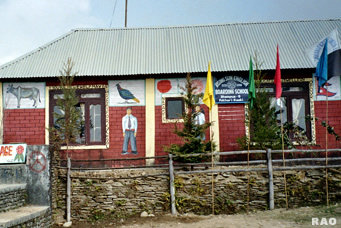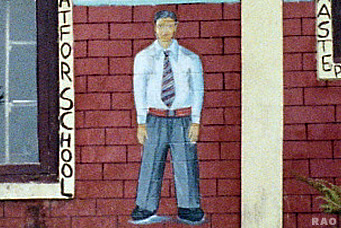|
Education
in Nepal: Reports
|
 |
Nepal EDUCATION |
|
|
 |
|
Rural
community schools under political pressure
|
 |
KATHMANDU,
27 March 2006 (IRIN)
Over
2,000 of the country's community-managed schools, regarded by education
experts as the best model for quality schooling in rural areas, are coming
under immense political pressure both from the Maoists - who have been
waging an armed rebellion against the state for the last 10 years - and
the Nepal National Teachers' Association (NNTA), a union of 80,000 government
school teachers.
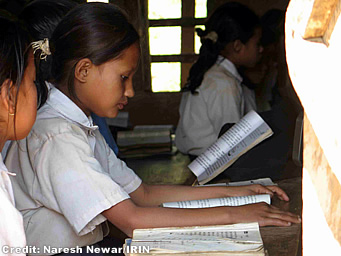 |
| Many poor children in rural areas have a chance to get a quality education
in community schools. Pressure from Maoists on these schools has been affecting
the education of thousands of children in remote areas
According
to reports by local government education offices in rural areas, a large
number of community-based schools are being routinely locked up or their
classes disrupted.
Since
2003, with financial support from the World Bank, the Ministry of Education
(MoE) has been transferring the management responsibilities of public schools
to local communities, comprising of parents, community leaders and teachers.
The government provides a grant of US $1,500 to each community-managed
school. |
|
Under
its Community School Support Programme (CSSP), the MoE, in a bid to make
schools independent from government control while improving school efficiency,
has handed over 2,292 schools to communities in 62 of the 75 districts
in the Himalayan kingdom.
Additionally,
they have been given the authority to supervise, as well as to hire and
suspend, those teachers who neglect their duties or stay absent from class
for long periods of time.
The United
Nations Children's Fund (UNICEF) believes that effort has proved successful
in enrolling and keeping more children in village schools, where according
to the MoE, over 4 million of Nepal's children under 15 years of age are
still not going to school. So far only 6 million, or 82 percent, of children
are currently enrolled at the primary school level.
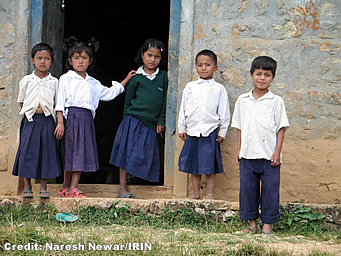 |
| But
due to inefficient and poor quality public education, less than 67 percent
of the children make it to grade five, while less than a third of primary
school students manage to enter lower secondary schools. Nepal has one
of the highest school dropout rates in the world, with nearly 70 percent
of Nepalese children between the ages of six and 10 years of age dropping
out due to poverty, lack of teachers and poorly managed public schools.
With
community schools, however, there is hope of a better public education
system amongst poor families in Nepal, particularly in rural areas - where
nearly 86 percent of the country's 27 million inhabitants live. |
|
"Handing
over the schools to communities is very good and an effective homegrown
initiative as it had proved to be a successful education model. There is
no credible alternative for the country's education system," asserted Rajendra
Joshi, a senior education specialist at the World Bank in Kathmandu.
Backing
up the stance, the bank has also committed more financial support to this
programme due to its many positive outcomes.
But
recently the Maoists have demanded that the government take back the management
responsibilities of the public schools given to the local communities,
accusing the state of running away from its responsibilities. In addition,
the NNTA expressed concerns that the communities were not capable enough
to run the schools without government supervision.
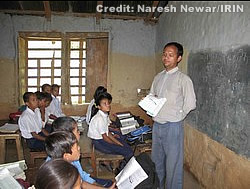 |
| Teachers have been especially targeted in the conflict, allegedly by both
rebels and the army. Narjit Basnet's hand was chopped off by Maoist rebels.
He still manages to teach the children at a community school.
"Managing
schools is a huge challenge, both academically and financially, and local
communities are not prepared in both cases. The decision (to hand over
schools to communities) can have negative consequences," maintained NNTA's
General Secretary Baburam Adhikari.
Yet
government authorities maintain this is nothing but a political motive,
with many teachers merely concerned about their own job security. |
|
"We
should look at the fact that today more poor children are staying longer
in schools. This proves that communities are doing a very good job," Om
Sharma, an official from the Department of Education, explained.
A
recent 2006 World Bank survey of 10,000 households in 33 schools showed
that the rate of school dropouts at primary school level had dropped from
13.7 percent to 9.5 percent.
"When
the political crisis and the insurgency have made development work more
challenging, there is increasing evidence and realisation that letting
the communities lead the way is the smart approach to sustain development,"
World Bank chief in Nepal, Ken Ohasi, was quoted as saying by the Nepali
Times, a national weekly, while referring to the conflict's impact on the
country's education system.
Credit
IRIN 2007
Copyright
© UN Office for the Coordination of Humanitarian Affairs 2007
[
This report does not necessarily reflect the views of the United Nations]
Integrated
Regional Information Networks (IRIN), part of the UN Office for the Coordination
of Humanitarian Affairs (OCHA). |
 |
top
|
Links
|
 |
 |
 |
Externe
Links |
 |
| more information |
 |

|
|
Children
from Kavre village, Dolakha district
|
|





